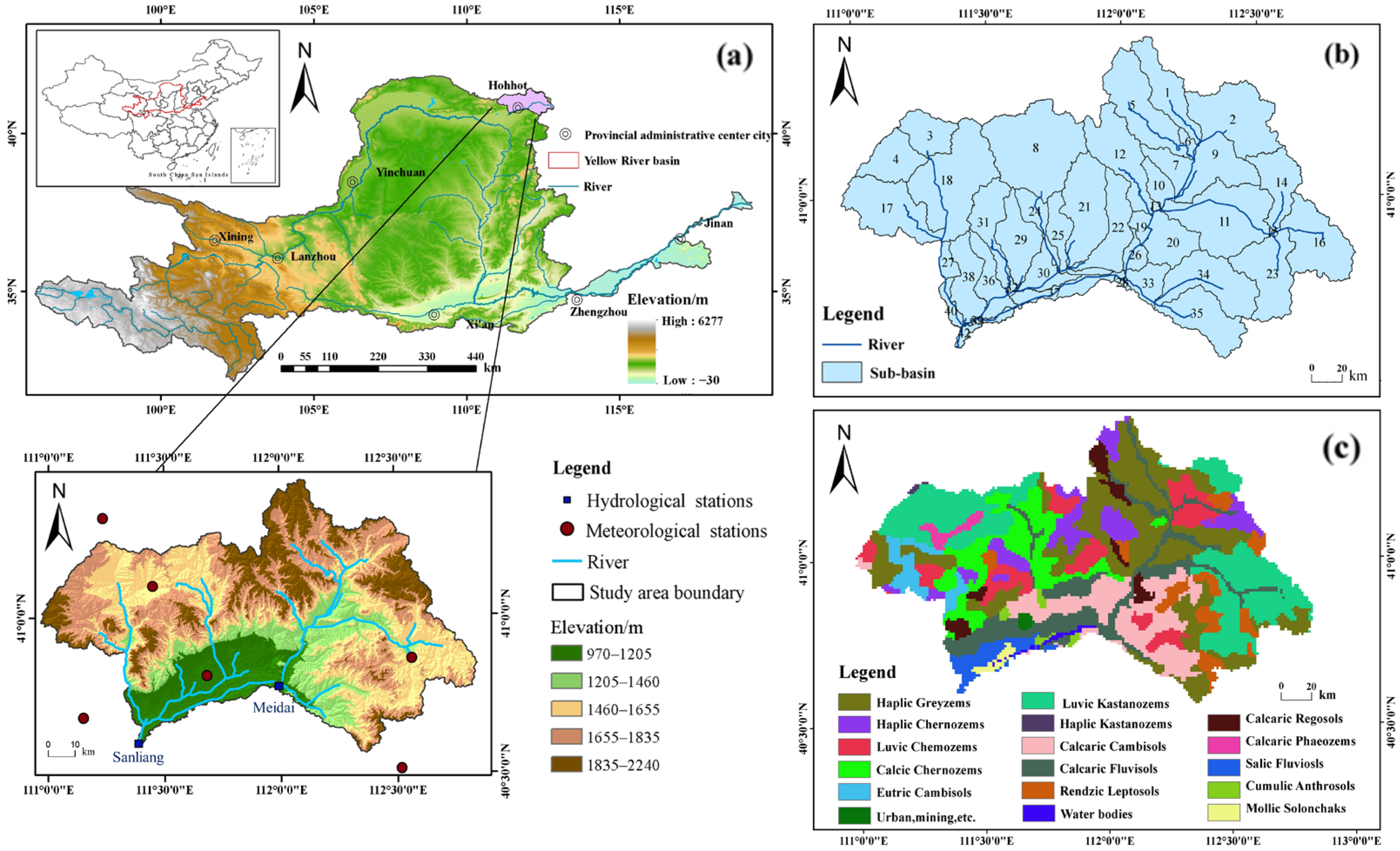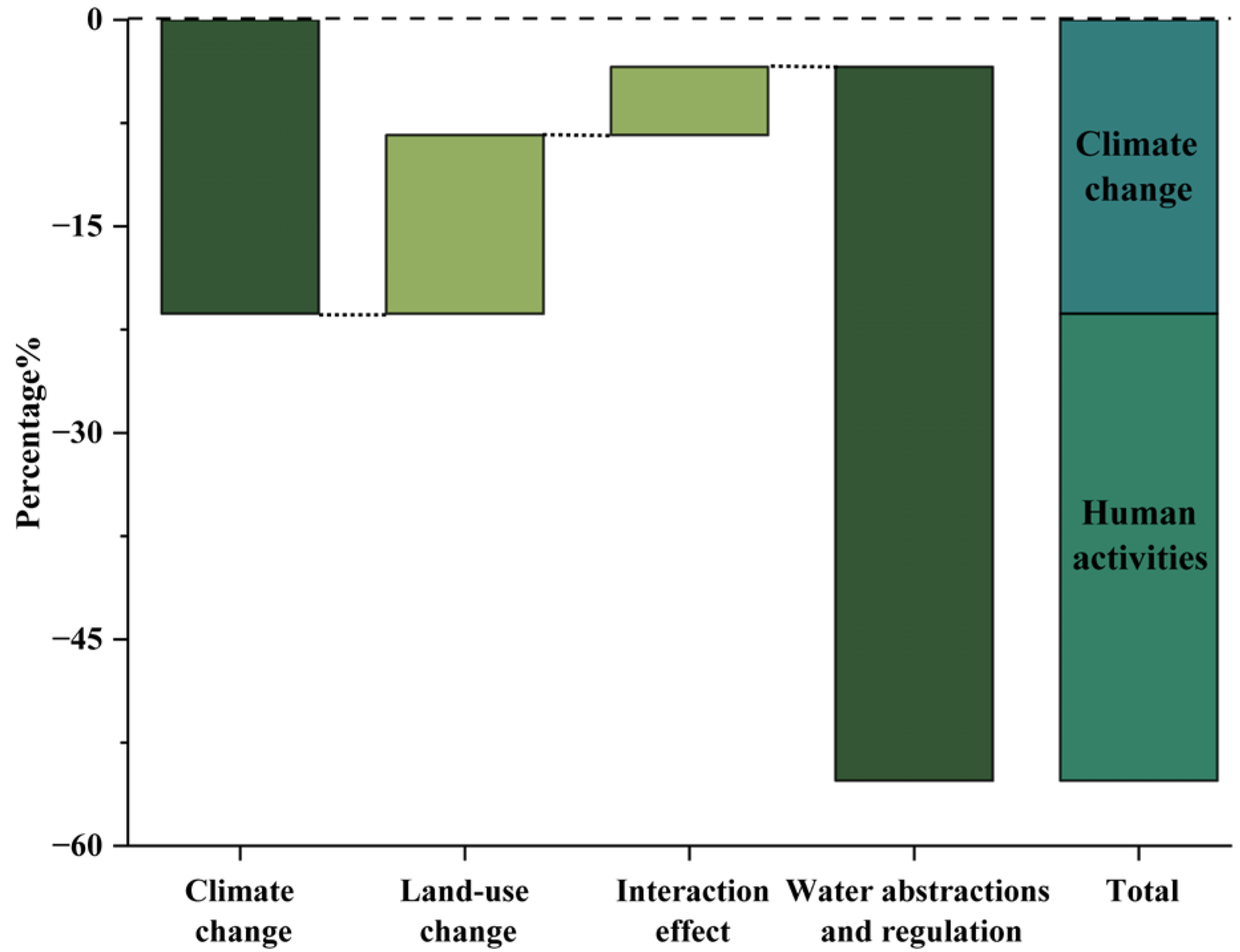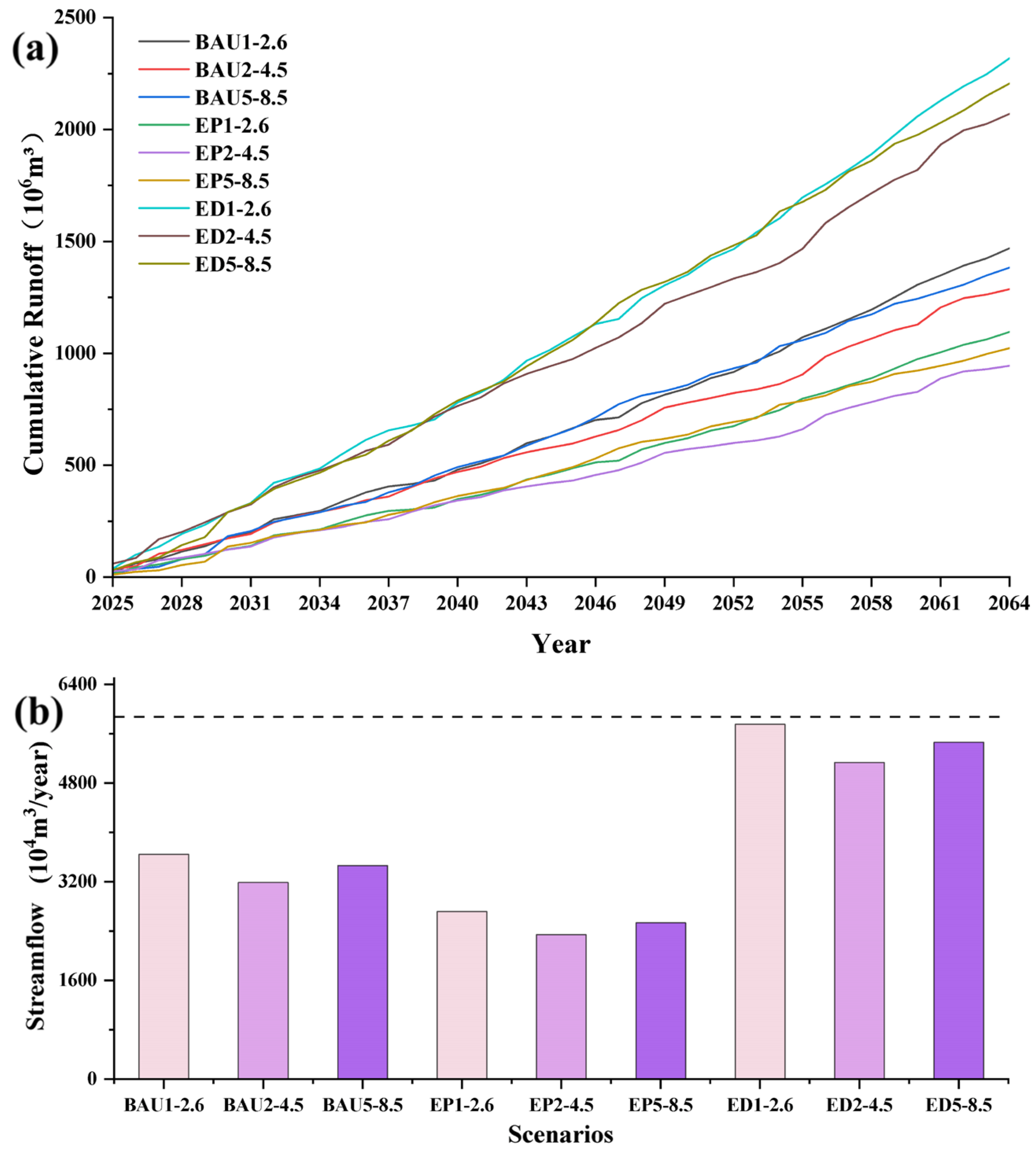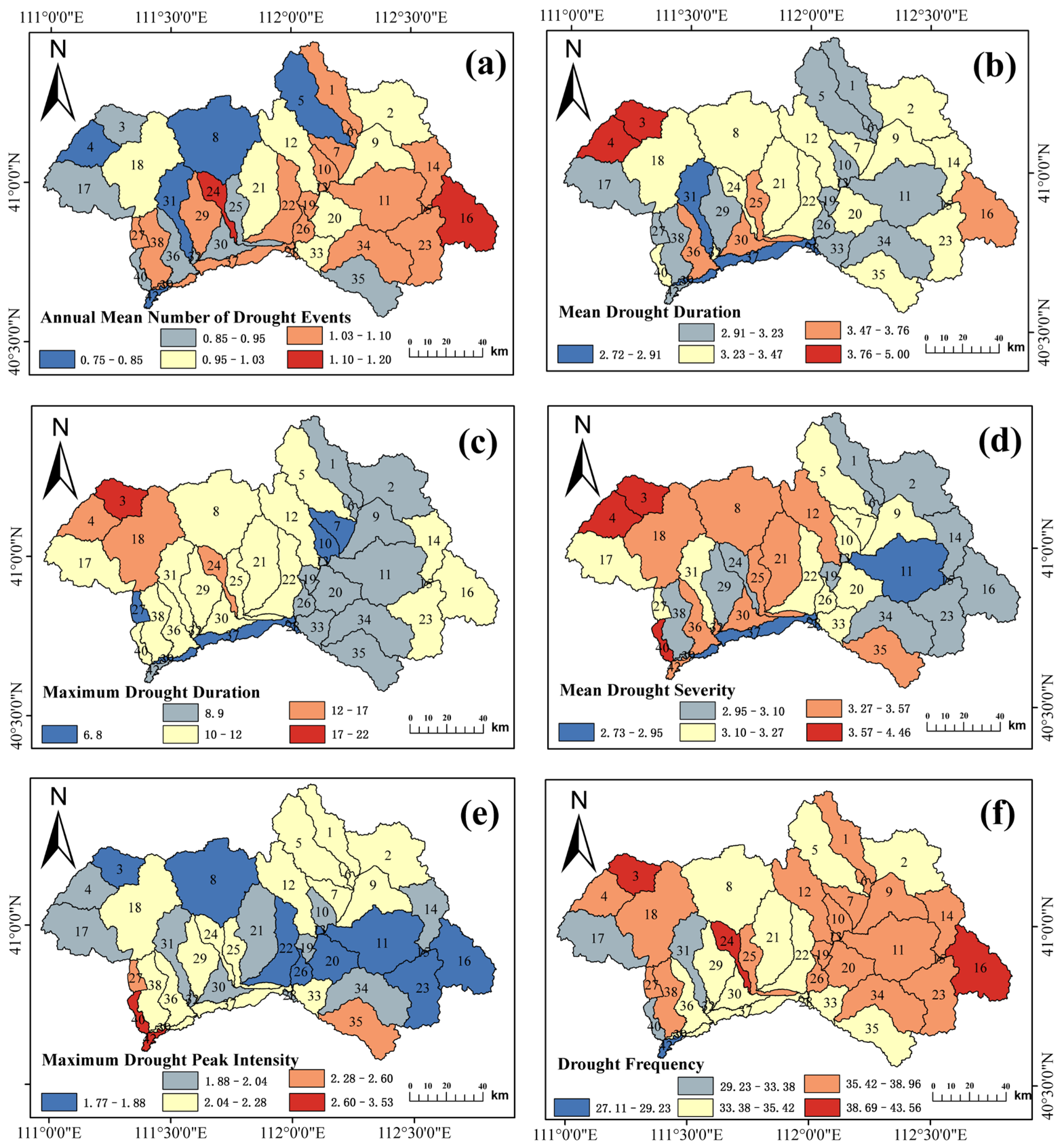Drivers and Future Regimes of Runoff and Hydrological Drought in a Critical Tributary of the Yellow River Under Climate Change
Abstract
1. Introduction
2. Materials and Methods
2.1. Study Area Overview
2.2. Data Sources and Preprocessing
2.3. Methods
2.3.1. SWAT Model Hydrological Processes’ Simulation, Model Calibration, and Validation
2.3.2. Pettitt Change-Point Test
2.3.3. Scenario Design
2.3.4. Hydrological Drought Index
2.3.5. Hydrological Drought Characteristics
2.3.6. Statistical and Regression Analysis Methods
- (1)
- Under fixed land use conditions, Newey–West robust regression is used to assess the effects of annual climatic variables on different runoff components;
- (2)
- Using 42 sub-basins as samples, ordinary least squares (OLS) regression is applied to analyze the effects of land use and slope on changes in the three runoff components;
- (3)
- Scenario-based decomposition and interaction-difference methods are used to quantitatively separate the contributions of climate change, land use change, and their interaction to runoff changes;
- (4)
- An SRI series is constructed from the baseline-period monthly runoff at Sanliang Station, drought characteristics are extracted for the two periods, and scenario-based attribution is performed accordingly;
- (5)
- A linear probability model (LPM) is employed to characterize the influence of climatic factors on the probability of hydrological drought occurrence at the monthly scale;
- (6)
- Under fixed climatic conditions, Spearman rank correlation analysis is used to identify through which runoff components land use change affects drought characteristics;
- (7)
- A mediation analysis based on nonparametric bootstrap is used to estimate the indirect effects of land use change on hydrological drought characteristics via SURQ, LATQ, and GWQ.
3. Results
3.1. Model Calibration and Validation of the SWAT Model for the Middle and Upper Dahei River Basin
3.2. Pettitt Breakpoint Test
3.3. Attribution Analysis of Runoff Variations
3.3.1. Attribution Analysis of Total Runoff Variation
3.3.2. Impact of Climate Change on Runoff Components
3.3.3. Effects of Land Use and Slope Variation on Three Runoff Components
3.3.4. Effects of Climate-Land Use Change Interaction Effect on Runoff Components
3.4. Attribution Analysis of Changes in Hydrological Drought Characteristics
3.4.1. Impact of Climate Change on the Occurrence of Hydrological Drought
3.4.2. Mechanism Analysis of Land Use Change and Interaction Effects on Hydrological Drought Characteristics
3.5. Simulation of Total Runoff in Future Periods and Analysis of Spatial Characteristics of Hydrological Drought
3.5.1. Multi-Scenario Total Runoff Simulation for Future Periods
3.5.2. Spatial Characteristics of Hydrological Drought Analysis
4. Discussion
4.1. Model Simulation Performance
4.2. Attribution Analysis of Changes in Runoff Volume and Hydrological Drought Characteristics
4.3. Recommendations for Future Water Resources Management and Drought Mitigation Strategies
4.4. Uncertainty Analysis
5. Conclusions
- (1)
- The SWAT model performed well in simulating monthly runoff at the Meidai and Sanliang hydrological stations in the study area. Parameters such as ESCO, SMFMN, CN2, CH_N2, and SOL_K were discovered to be relatively sensitive parameters affecting runoff simulation.
- (2)
- Total runoff in the study area decreased by 55.26% during the impact period (1999–2022) as compared to the baseline period (1983–1998). In this decline, climate change accounted for a contribution rate of 38.6%, while human activities accounted for 61.4%. Particularly, climate change reduced runoff by 21.34%, while land use change increased runoff by 12.97%. The climate and land use’s interaction effect increased runoff by 4.95%. Climate primarily altered SURQ and LATQ through precipitation changes, while land use mainly influenced total runoff by modifying SURQ. Both factors had minor effects on subsurface runoff. Half the variation in SURQ is due to the interaction between climate and land use accounts.
- (3)
- Human activities significantly influence the intensification of hydrological drought (contribution rate: 36.11–94.25%). While climate change alone tends to worsen drought characteristics, land use change has the opposite effect. The impact of the interaction between climate and land use change has on all hydrological drought characteristics is comparatively weak. Climate change can notably reduce the probability of drought by increasing precipitation and raising minimum temperatures; in contrast, increasing maximum temperatures leads to an increase in drought probability. Land use impacts drought primarily through three runoff components.
- (4)
- It is predicted that over the next 40 years, total runoff will decrease by 2.08% to 60.16%. Under identical climatic conditions, ED > BAU > EP, and under identical land use conditions, SSP1-2.6 > SSP5-8.5 > SSP2-4.5. Hydrological drought characteristics exhibit the pattern of “more frequent, longer in average duration, and more intense hydrological droughts; however, Maximum Drought Duration is anticipated to shorten.” In the eastern and northeastern parts of the study area, hydrological droughts show strengthening trends; meanwhile, in the central and western regions, these droughts exhibit weaker or declining trends.
Supplementary Materials
Author Contributions
Funding
Institutional Review Board Statement
Informed Consent Statement
Data Availability Statement
Conflicts of Interest
References
- Wang, Q.; Xu, Y.; Wang, Y.; Zhang, Y.; Xiang, J.; Xu, Y.; Wang, J. Individual and combined impacts of future land-use and climate conditions on extreme hydrological events in a representative basin of the Yangtze River Delta, China. Atmos. Res. 2020, 236, 104805. [Google Scholar] [CrossRef]
- Aryal, S.; Babel, M.S.; Gupta, A.; Farjad, B.; Khadka, D.; Hassan, Q.K. Attribution of the Climate and Land Use Change Impact on the Hydrological Processes of Athabasca River Basin, Canada. Hydrology 2025, 12, 7. [Google Scholar] [CrossRef]
- Devkota, N.; Lamichhane, S.; Bhattarai, P.K. Navigating Uncertainties in Quantifying Water Availability Amidst the Climate and Land Use Changes. Water Resour. Manag. 2025, 39, 6791–6821. [Google Scholar] [CrossRef]
- Gao, J.; Bieger, K.; White, M.J.; Arnold, J.G. Development and accuracy assessment of a 12-digit hydrologic unit code based real-time climate database for hydrologic models in the US. J. Hydrol. 2020, 586, 124817. [Google Scholar] [CrossRef]
- Luo, Y.; Yang, Y.; Yang, D.; Zhang, S. Quantifying the impact of vegetation changes on global terrestrial runoff using the Budyko framework. J. Hydrol. 2020, 590, 125389. [Google Scholar] [CrossRef]
- Yang, S.; Yang, D.; Zhao, B.; Ma, T.; Lu, W.; Santisirisomboon, J. Future changes in high and low flows under the impacts of climate and land use changes in the Jiulong River Basin of southeast China. Atmosphere 2022, 13, 150. [Google Scholar] [CrossRef]
- Yin, J.; He, F.; Xiong, Y.J.; Qiu, G.Y. Effects of land use/land cover and climate changes on surface runoff in a semi-humid and semi-arid transition zone in northwest China. Hydrol. Earth Syst. Sci. 2017, 21, 183–196. [Google Scholar] [CrossRef]
- Yang, M.; Xue, L.; Liu, Y.; Wang, W.; Han, Q.; Liu, S.; Fu, R. Runoff response to multiple land-use changes and climate perturbations. Hydrol. Process. 2024, 38, e15072. [Google Scholar] [CrossRef]
- Bian, G.; Wang, G.; Chen, J.; Zhang, J.; Song, M. Spatial and seasonal variations of hydrological responses to climate and land-use changes in a highly urbanized basin of Southeastern China. Hydrol. Res. 2021, 52, 506–522. [Google Scholar] [CrossRef]
- Shaukat, R.S.; Khan, M.M.; Shahid, M.; Khan, T.A.; Aslam, M.A. Quantitative Contribution of Climate Change and Land Use Change to Runoff in Tarbela Catchment, Pakistan. Pol. J. Environ. Stud. 2020, 29, 3295–3304. [Google Scholar] [CrossRef]
- Ruigar, H.; Emamgholizadeh, S.; Gharechelou, S.; Golian, S. Evaluating the impacts of anthropogenic, climate, and land use changes on streamflow. J. Water Clim. Chang. 2024, 15, 1885–1905. [Google Scholar] [CrossRef]
- Mahmood, S.; Khan, A.U.; Babur, M.; Ghanim, A.A.J.; Al-Areeq, A.M.; Khan, D.; Najeh, T.; Gamil, Y. Divergent path: Isolating land use and climate change impact on river runoff. Front. Environ. Sci. 2024, 12, 1338512. [Google Scholar] [CrossRef]
- Liu, J.; Xue, B.; Yan, Y. The assessment of climate change and land-use influences on the runoff of a typical coastal basin in Northern China. Sustainability 2020, 12, 10050. [Google Scholar] [CrossRef]
- Iqbal, M.; Wen, J.; Masood, M.; Masood, M.U.; Adnan, M. Impacts of climate and land-use changes on hydrological processes of the source region of Yellow River, China. Sustainability 2022, 14, 14908. [Google Scholar] [CrossRef]
- Du, B.; Wu, L.; Ruan, B.; Xu, L.; Liu, S. CMADS and CFSR data-driven SWAT modeling for impacts of climate and land-use change on runoff. Water 2023, 15, 3240. [Google Scholar] [CrossRef]
- Sharma, A.; Patel, P.; Sharma, P.J. Influence of climate and land-use changes on the sensitivity of SWAT model parameters and water availability in a semi-arid river basin. CATENA 2022, 215, 106298. [Google Scholar] [CrossRef]
- Wang, X.; Liu, L. The impacts of climate change on the hydrological cycle and water resource management. Water 2023, 15, 2342. [Google Scholar] [CrossRef]
- Tabari, H.; Meng, R. Contrasting responses of drought and floods to background aridity in a changing climate across global terrestrial ecosystems. In Proceedings of the Göttingen: Copernicus Meetings, Vienna, Austria, 14–19 April 2024. [Google Scholar]
- Parvaze, S.; Kumar, R.; Khan, J.N.; Parvaze, S. Climate Change, Drought, and Water Resources, Integrated Drought Management; CRC Press: Boca Raton, FL, USA, 2023; Volume 1, pp. 541–568. [Google Scholar]
- IPCC. Climate Change 2023: Synthesis Report; Cambridge University Press: Cambridge, UK, 2023. [Google Scholar]
- Trut, D.; Kovačević, J. Climate change, disaster risk reduction and resilience. Environ. Eng.-Inženjerstvo Okoliša 2022, 9, 35–42. [Google Scholar] [CrossRef]
- Shiferaw, N.; Habte, L.; Waleed, M. Land use dynamics and their impact on hydrology and water quality of a river catchment: A comprehensive analysis and future scenario. Environ. Sci. Pollut. Res. 2025, 32, 4124–4136. [Google Scholar] [CrossRef]
- Liu, W.; Wu, J.; Xu, F.; Mu, D.; Zhang, P. Modeling the effects of land use/land cover changes on river runoff using SWAT models: A case study of the Danjiang River source area, China. Environ. Res. 2024, 242, 117810. [Google Scholar] [CrossRef]
- Chen, H.; Meng, F.; Sa, C.; Luo, M.; Zhang, H.; Bao, S.; Liu, G.; Bao, Y. Synergistic Change and Driving Mechanisms of Hydrological Processes and Ecosystem Quality in a Typical Arid and Semi-Arid Inland River Basin, China. Remote Sens. 2023, 15, 1785. [Google Scholar] [CrossRef]
- Wang, Y.; Meng, F.; Luo, M. Quantitative assessment of the dynamics and attribution of arable land water scarcity for arid and semiarid areas based on water footprint framework: The Inner Mongolia case. Water Supply 2022, 22, 391–408. [Google Scholar] [CrossRef]
- Zhang, J.; Meng, F.; Luo, M.; Fang, Y.; Chen, H.; Sa, C.; Chi, W.; Bao, Y. Grazing strategy shifts mitigate the negative effects of drought on grassland productivity in Inner Mongolia. Ecol. Indic. 2025, 178, 114098. [Google Scholar] [CrossRef]
- Meng, F.; Liu, T.; Huang, Y.; Luo, M.; Bao, A.; Hou, D. Quantitative detection and attribution of runoff variations in the Aksu River Basin. Water 2016, 8, 338. [Google Scholar] [CrossRef]
- Pourzand, F.; Noy, I. Catastrophic droughts and their economic consequences. In Oxford Research Encyclopedia of Environmental Science; Oxford University Press: Oxford, UK, 2022. [Google Scholar]
- Cavalcante, L.; Walker, D.W.; Kchouk, S.; Neto, G.R.; Carvalho, T.M.N.; de Brito, M.M.; Pot, W.; Dewulf, A.; van Oel, P. From insufficient rainfall to livelihoods: Understanding the cascade of drought impacts and policy implication. EGUsphere 2024, 2024, 1–20. [Google Scholar] [CrossRef]
- Ehtasham, L.; Sherani, S.H.; Nawaz, F. Acceleration of the hydrological cycle and its impact on water availability over land: An adverse effect of climate change. Meteorol. Hydrol. Water Manag. 2024, 12, 1–21. [Google Scholar] [CrossRef]
- Yue, C.H.; Gao, R.Z.; Duan, L.M.; Tong, H.; Xie, L.M.; Fang, L.G.; Wang, K.L.; Sun, B. Spatial and Temporal Characteristics and Controlling Factors of Water Quality of the Dahei River in the Yellow River Basin. Environ. Sci. 2025, 46, 774–785. [Google Scholar]
- Wei, H.B.; Zhang, Z.P.; Yang, J.P. Establishing method for soil database of SWAT model. Water Resour. Hydropower Eng. 2007, 38, 15–18. [Google Scholar]
- Kim, Y.H.; Min, S.K.; Zhang, X.; Sillmann, J.; Sandstad, M. Evaluation of the CMIP6 multi-model ensemble for climate extreme indices. Weather Clim. Extrem. 2020, 29, 100269. [Google Scholar] [CrossRef]
- Zhu, H.; Jiang, Z.; Li, J.; Li, W.; Sun, C.; Li, L. Does CMIP6 inspire more confidence in simulating climate extremes over China? Adv. Atmos. Sci. 2020, 37, 1119–1132. [Google Scholar] [CrossRef]
- Neupane, R.P.; White, J.D.; Alexander, S.E. Projected hydrologic changes in monsoon-dominated Himalaya Mountain basins with changing climate and deforestation. J. Hydrol. 2015, 525, 216–230. [Google Scholar] [CrossRef]
- Nash, J.E.; Sutcliffe, J.V. River flow forecasting through conceptual models part I—A discussion of principles. J. Hydrol. 1970, 10, 282–290. [Google Scholar] [CrossRef]
- Wang, Y.; Peng, T.; He, Y.; Singh, V.P.; Lin, Q.; Dong, X.; Fan, T.; Liu, J.; Guo, J.; Wang, G. Attribution analysis of non-stationary hydrological drought using the GAMLSS framework and an improved SWAT model. J. Hydrol. 2023, 627, 130420. [Google Scholar] [CrossRef]
- Mikaeili, O.; Shourian, M. Assessment of the analytic and hydrologic methods in separation of watershed response to climate and land use changes. Water Resour. Manag. 2023, 37, 2575–2591. [Google Scholar] [CrossRef]
- Rocha, A.K.P.; de Souza, L.S.B.; de Assunção Montenegro, A.A.; de Souza, W.M.; da Silva, T.G.F. Revisiting the application of the SWAT model in arid and semi-arid regions: A selection from 2009 to 2022. Theor. Appl. Climatol. 2023, 154, 7–27. [Google Scholar] [CrossRef]
- Liu, P.; Liu, D.; Khan, M.Y.A.; Zheng, X.; Hu, Y.; Ming, G.; Gao, M. Multivariate Validation at Multistation of Distributed Watershed Hydrological Modeling Based on Multisource Data on Chinese Loess Plateau. Water 2024, 16, 1823. [Google Scholar] [CrossRef]
- Ogunrinde, A.T.; Adeyeri, O.E.; Xian, X.; Yu, H.; Jing, Q.; Faloye, O.T. Long-term spatiotemporal trends in precipitation, temperature, and evapotranspiration across arid Asia and Africa. Water 2024, 16, 3161. [Google Scholar] [CrossRef]
- Huang, S.; Gan, Y.; Chen, N.; Wang, C.; Zhang, X.; Li, C.; Horton, D.E. Urbanization enhances channel and surface runoff: A quantitative analysis using both physical and empirical models over the Yangtze River basin. J. Hydrol. 2024, 635, 131194. [Google Scholar] [CrossRef]
- Zhang, J.; Wang, Z.; Zhuang, D.; Fu, Z.; Wang, K.; Chen, H. Evaluating the hydrological function of vegetation restoration in fragile karst area: Insights from the continuous surface and subsurface runoff monitoring. Soil Tillage Res. 2023, 234, 105847. [Google Scholar] [CrossRef]
- Liu, B.; Yang, J.; Sha, J.; Luo, Y.; Zhao, X.; Liu, R. Analysis of runoff according to land-use change in the upper Hutuo River basin. Water 2023, 15, 1138. [Google Scholar] [CrossRef]
- Ridwansyah, I.; Yulianti, M.; Apip, S.; Onodera, S.-I.; Shimizu, Y.; Wibowo, H.; Fakhrudin, M. The impact of land use and climate change on surface runoff and groundwater in Cimanuk watershed, Indonesia. Limnology 2020, 21, 487–498. [Google Scholar] [CrossRef]
- Yan, Y.; Xue, B.; Yinglan, A.; Sun, W.; Zhang, H. Quantification of climate change and land cover/use transition impacts on runoff variations in the upper Hailar Basin, NE China. Hydrol. Res. 2020, 51, 976–993. [Google Scholar] [CrossRef]
- Ni, Y.; Yu, Z.; Lv, X.; Qin, T.; Yan, D.; Zhang, Q.; Ma, L. Spatial difference analysis of the runoff evolution attribution in the Yellow River Basin. J. Hydrol. 2022, 612, 128149. [Google Scholar] [CrossRef]
- Guo, Y.; Fang, G.; Xu, Y.-P.; Tian, X.; Xie, J. Identifying how future climate and land use/cover changes impact streamflow in Xinanjiang Basin, East China. Sci. Total Environ. 2020, 710, 136275. [Google Scholar] [CrossRef]
- Ghaneei, P.; Moradkhani, H. DeepBase: A Deep Learning-based Daily Baseflow Dataset across the United States. Sci. Data 2025, 12, 25. [Google Scholar] [CrossRef]
- Song, Y.H.; Chung, E.-S.; Shahid, S. Differences in extremes and uncertainties in future runoff simulations using SWAT and LSTM for SSP scenarios. Sci. Total Environ. 2022, 838, 156162. [Google Scholar] [CrossRef] [PubMed]
- Wu, J.; Chen, X.; Yu, Z.; Yao, H.; Li, W.; Zhang, D. Assessing the impact of human regulations on hydrological drought development and recovery based on a ‘simulated-observed’ comparison of the SWAT model. J. Hydrol. 2019, 577, 123990. [Google Scholar] [CrossRef]
- Lin, B.; Chen, X.; Yao, H.; Chen, Y.; Liu, M.; Gao, L.; James, A. Analyses of landuse change impacts on catchment runoff using different time indicators based on SWAT model. Ecol. Indic. 2015, 58, 55–63. [Google Scholar] [CrossRef]
- Thavhana, M.; Savage, M.; Moeletsi, M. SWAT model uncertainty analysis, calibration and validation for runoff simulation in the Luvuvhu River catchment, South Africa. Phys. Chem. Earth Parts A/B/C 2018, 105, 115–124. [Google Scholar] [CrossRef]
- Li, J.; Miao, C.; Wei, W.; Zhang, G.; Hua, L.; Chen, Y.; Wang, X. Evaluation of CMIP6 global climate models for simulating land surface energy and water fluxes during 1979–2014. J. Adv. Model. Earth Syst. 2021, 13, e2021MS002515. [Google Scholar] [CrossRef]
- Wang, Q.; Xia, J.; She, D.; Zhang, X.; Liu, J.; Zhang, Y. Assessment of four latest long-term satellite-based precipitation products in capturing the extreme precipitation and streamflow across a humid region of southern China. Atmos. Res. 2021, 257, 105554. [Google Scholar] [CrossRef]
- Fan, X.; Miao, C.; Duan, Q.; Shen, C.; Wu, Y. The performance of CMIP6 versus CMIP5 in simulating temperature extremes over the global land surface. J. Geophys. Res. Atmos. 2020, 125, e2020JD033031. [Google Scholar] [CrossRef]







| Order | Parameter | Meaning (with Units) | Best Parameters | t-Stat | p-Value |
|---|---|---|---|---|---|
| 1 | ESCO | Soil evaporation compensation factor: adjusts the depth in soil from which evaporation demand is met (dimensionless). | 0.05 | 3.73 | 0.0008 |
| 2 | SMFMN | Snowmelt factor for winter: the minimum melt rate of snow per degree-day (mm/°C-day). | 16.44 | −2.69 | 0.01 |
| 3 | CN2 | SCS runoff curve number for average moisture condition (II): an index of runoff potential for soil and land cover (dimensionless). | −0.26 | −2.16 | 0.04 |
| 4 | CH_N2 | Manning’s roughness coefficient for the main channel: influencing flow resistance in the channel (dimensionless). | 0.02 | −2.07 | 0.05 |
| 5 | SOL_K | Saturated hydraulic conductivity of the soil layer: measuring the ease of water movement through saturated soil (mm/h). | −0.87 | −1.77 | 0.09 |
| 6 | ALPHA_BF | Baseflow alpha factor: the groundwater baseflow recession constant that controls the rate of baseflow decline (1/day). | −0.15 | 0.95 | 0.34 |
| 7 | HRU_SLP | Average slope steepness of the HRU (m/m). | −0.41 | −0.94 | 0.35 |
| 8 | SOL_BD | Soil bulk density: mass of soil per unit volume (g/cm3). | 1.27 | 0.93 | 0.36 |
| 9 | GWQMN | Threshold water depth in the shallow aquifer required for return flow to occur (m/m). | 0.56 | 0.77 | 0.45 |
| 10 | CANMX | Maximum canopy storage: the maximum water that can be held on the vegetation canopy (m/m). | 0.78 | −0.73 | 0.47 |
| 11 | SOL_AWC | Available water capacity of the soil layer: fraction of water that can be stored in soil for plants (mm/mm). | 0.82 | −0.63 | 0.54 |
| 12 | OV_N | Manning’s roughness coefficient for overland flow (dimensionless). | 0.27 | 0.50 | 0.62 |
| 13 | SLSUBBSN | Average slope length for overland flow; the distance of sheet flow before runoff concentrates into channels (m). | −0.24 | 0.42 | 0.67 |
| 14 | EPCO | Plant uptake compensation factor: adjusts how deeply plant roots can draw water (dimensionless). | 0.51 | 0.34 | 0.74 |
| 15 | GW_REVAP | Groundwater re-evaporation coefficient: controls the fraction of water moving from the shallow aquifer up to the root zone (dimensionless). | 0.77 | −0.14 | 0.88 |
| 16 | TIMP | Snowpack temperature lag factor: controls the influence of the previous day’s snowpack temperature on today’s (dimensionless). | 0.57 | 0.14 | 0.89 |
| 17 | GW_DELAY | Groundwater delay time: the lag between water percolation from the soil and its recharge to the shallow aquifer (days). | 606.16 | 0.13 | 0.90 |
| 18 | USLE_P | USLE support practice factor: ratio of soil loss with a given conservation practice to the loss with conventional farming (dimensionless). | 1.65 | −0.12 | 0.92 |
| 19 | SFTMP | Snowfall temperature threshold: the mean air temperature at which precipitation is equally likely to be rain or snow (°C). | −0.87 | 0.09 | 0.93 |
| 20 | REVAPMN | Threshold water depth in the shallow aquifer required for upward flow to soil or percolation to the deep aquifer (mm). | 806.70 | 0.01 | 0.99 |
| Scenario | Dataset |
|---|---|
| Baseline period scenario (S1) | 1983–1998 climate and 1990 Land use |
| Climate change scenario (S2) | Climate from 1999–2022 and Land use in 1990 |
| Land use change scenario (S3) | Climate from 1983–1998 and Land use in 2020 |
| Integrated Change Scenario (S4) | Climate 1999–2022 and Land Use 2020 |
| BAU1-2.6 Scenario (S5) | SSP1-2.6 Climate for 2025–2064 and BAU Land Use for 2045 |
| BAU2-4.5 Scenario (S6) | SSP2-4.5 Climate Scenario for 2025–2064 and BAU Land Use for 2045 |
| BAU5-8.5 Scenario (S7) | SSP5-8.5 Climate for 2025–2064 and BAU Land Use for 2045 |
| EP1-2.6 Scenario (S8) | SSP1-2.6 climate for 2025–2064 and EP Land use for 2045 |
| EP2-4.5 Scenario (S9) | 2025–2064 SSP2-4.5 Climate and 2045 EP Land Use |
| EP5-8.5 Scenario (S10) | 2025–2064 SSP5-8.5 Climate and 2045 EP Land Use |
| ED1-2.6 Scenario (S11) | 2025–2064 SSP1-2.6 Climate and 2045 ED Land Use |
| ED2-4.5 Scenario (S12) | 2025–2064 SSP2-4.5 Climate and 2045 ED Land Use |
| ED5-8.5 Scenario (S13) | SSP5-8.5 climate for 2025–2064 and ED Land use for 2045 |
| Hydrological Drought Feature | Measured Relative Change (%) | Climate Effect % | Land Use Effect % | Interaction Effect % | Water Withdrawal and Regulation Effect % | Climate Contribution Rate | Human Activity Contribution Rate |
|---|---|---|---|---|---|---|---|
| Annual Mean Number of Drought Events | 100 | 5.75 | −21.05 | 3.51 | 111.79 | 5.75 | 94.25 |
| Mean Drought Duration | 42.71 | 8.37 | −11.14 | 6.75 | 38.74 | 19.60 | 80.40 |
| Maximum Drought Duration | 133.33 | 0.00 | −40.00 | −20.00 | 193.33 | 0.00 | 100 |
| Mean Drought Severity | 110.32 | 20.89 | −9.33 | 2.50 | 96.26 | 18.94 | 81.06 |
| Maximum Drought Peak Intensity | 19.55 | 12.49 | 0.00 | −9.61 | 16.67 | 63.89 | 36.11 |
| Drought Frequency | 106.94 | 2.63 | −22.37 | 3.95 | 122.73 | 2.46 | 97.54 |
Disclaimer/Publisher’s Note: The statements, opinions and data contained in all publications are solely those of the individual author(s) and contributor(s) and not of MDPI and/or the editor(s). MDPI and/or the editor(s) disclaim responsibility for any injury to people or property resulting from any ideas, methods, instructions or products referred to in the content. |
© 2025 by the authors. Licensee MDPI, Basel, Switzerland. This article is an open access article distributed under the terms and conditions of the Creative Commons Attribution (CC BY) license (https://creativecommons.org/licenses/by/4.0/).
Share and Cite
Wang, Y.; Wang, Y.; Fang, W.; Zhao, Y.; Zhou, Y.; Wang, F. Drivers and Future Regimes of Runoff and Hydrological Drought in a Critical Tributary of the Yellow River Under Climate Change. Atmosphere 2025, 16, 1327. https://doi.org/10.3390/atmos16121327
Wang Y, Wang Y, Fang W, Zhao Y, Zhou Y, Wang F. Drivers and Future Regimes of Runoff and Hydrological Drought in a Critical Tributary of the Yellow River Under Climate Change. Atmosphere. 2025; 16(12):1327. https://doi.org/10.3390/atmos16121327
Chicago/Turabian StyleWang, Yu, Yong Wang, Wenya Fang, Yuhan Zhao, Ying Zhou, and Fangting Wang. 2025. "Drivers and Future Regimes of Runoff and Hydrological Drought in a Critical Tributary of the Yellow River Under Climate Change" Atmosphere 16, no. 12: 1327. https://doi.org/10.3390/atmos16121327
APA StyleWang, Y., Wang, Y., Fang, W., Zhao, Y., Zhou, Y., & Wang, F. (2025). Drivers and Future Regimes of Runoff and Hydrological Drought in a Critical Tributary of the Yellow River Under Climate Change. Atmosphere, 16(12), 1327. https://doi.org/10.3390/atmos16121327




